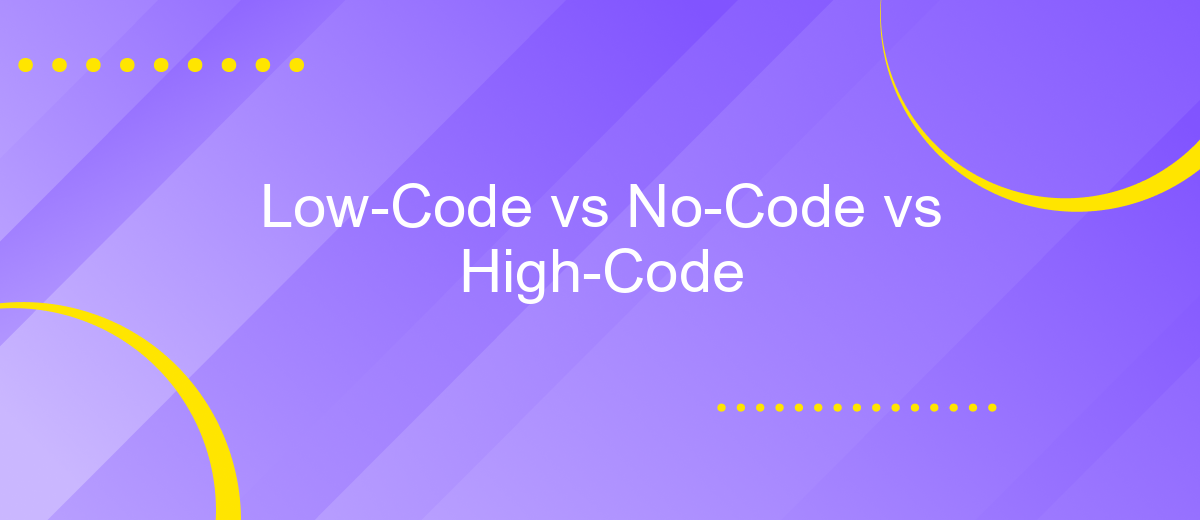Low-Code vs No-Code vs High-Code
As businesses strive for greater agility and innovation, the debate between low-code, no-code, and high-code development platforms intensifies. Each approach offers unique advantages and trade-offs, catering to different needs and skill levels. This article delves into the key distinctions, benefits, and challenges of low-code, no-code, and high-code solutions, helping you make an informed decision for your development strategy.
What is Low-Code?
Low-code development platforms enable users to create applications with minimal hand-coding, using visual interfaces and pre-built modules. These platforms are designed to accelerate the development process, making it more accessible to individuals who may not have extensive programming skills.
- Visual Development: Drag-and-drop interfaces simplify the design process.
- Pre-built Components: Utilize ready-made modules to speed up development.
- Integration Capabilities: Easily connect with various APIs and services like ApiX-Drive for seamless data flow.
- Scalability: Suitable for both small projects and large enterprise applications.
By leveraging low-code platforms, businesses can reduce the time and cost associated with traditional development. These tools empower a broader range of employees to contribute to the development process, fostering innovation and agility within the organization. With services like ApiX-Drive, integrating various systems and automating workflows becomes straightforward, further enhancing productivity.
What is No-Code?

No-Code is an approach to software development that allows users to create applications without writing any code. This method leverages visual development environments, where users can drag and drop components to build their applications. No-Code platforms are designed to be user-friendly, enabling individuals with little to no technical expertise to develop functional software solutions. This democratizes the development process, allowing businesses to quickly prototype and deploy applications without the need for extensive programming knowledge.
One of the key benefits of No-Code platforms is their ability to integrate various services effortlessly. For example, ApiX-Drive is a service that simplifies integration tasks by providing a user-friendly interface for connecting different applications. With ApiX-Drive, users can automate workflows and synchronize data across multiple platforms without writing a single line of code. This enhances productivity and allows businesses to focus on their core activities while ensuring seamless connectivity between their software solutions.
What is High-Code?

High-code development refers to traditional coding practices where developers write detailed and complex code using programming languages such as Java, Python, or C#. This approach provides maximum flexibility and control over the software development process, allowing for the creation of highly customized and scalable applications. High-code is often preferred for projects that require sophisticated functionalities, custom integrations, and high performance.
- Complete control over code and architecture.
- Ability to handle complex and unique requirements.
- Enhanced performance and scalability.
- Custom integrations with various APIs and services.
- Greater flexibility in choosing development tools and frameworks.
High-code development is ideal for enterprises needing tailored solutions that can evolve with their business needs. For instance, integrating multiple services through APIs can be efficiently managed using platforms like ApiX-Drive, which simplifies the integration process and ensures seamless data flow between different systems. While high-code demands more time and expertise, it ultimately delivers robust and versatile applications tailored to specific business requirements.
Comparison of Low-Code, No-Code, and High-Code

Low-code, no-code, and high-code development platforms each offer unique advantages and disadvantages, catering to different needs and skill levels. Low-code platforms provide a balance, allowing developers to create applications with minimal hand-coding while still offering customization options. No-code platforms, on the other hand, are designed for users with little to no programming experience, enabling rapid application development through visual interfaces.
High-code development requires extensive programming knowledge and offers the greatest flexibility and control over the final product. This approach is best suited for complex projects that demand intricate customization and scalability.
- Low-Code: Moderate coding required, customizable, faster development.
- No-Code: No coding required, user-friendly, limited customization.
- High-Code: Extensive coding required, highly customizable, longer development time.
When it comes to integrating various services and automating workflows, tools like ApiX-Drive can be invaluable. ApiX-Drive simplifies the process of connecting different applications, making it easier for both low-code and no-code developers to enhance their projects without extensive coding knowledge. This versatility ensures that businesses can choose the right development approach based on their specific needs and resources.
- Automate the work of an online store or landing
- Empower through integration
- Don't spend money on programmers and integrators
- Save time by automating routine tasks
Benefits and Use Cases
Low-Code and No-Code platforms significantly reduce the time and effort required to develop applications, making them ideal for businesses looking to accelerate their digital transformation. These platforms empower non-technical users to create functional applications through intuitive drag-and-drop interfaces, thus democratizing the development process. On the other hand, High-Code solutions offer unmatched flexibility and customization, catering to complex projects that demand intricate coding and specialized skills.
Use cases for Low-Code and No-Code platforms are diverse, ranging from automating simple workflows to developing customer-facing applications. For instance, ApiX-Drive facilitates seamless integration between various services, allowing businesses to automate data transfers without writing a single line of code. High-Code solutions, however, are best suited for enterprise-level applications requiring robust security, scalability, and custom features. Whether you're a startup needing quick deployment or an enterprise requiring detailed customization, understanding the benefits and use cases of each approach can guide you in selecting the right development strategy.
FAQ
What is the difference between Low-Code and No-Code platforms?
Which type of platform is best suited for professional developers?
Can Low-Code and No-Code platforms handle complex business processes?
How do Low-Code and No-Code platforms integrate with existing systems?
Are Low-Code and No-Code platforms secure?
Apix-Drive will help optimize business processes, save you from a lot of routine tasks and unnecessary costs for automation, attracting additional specialists. Try setting up a free test connection with ApiX-Drive and see for yourself. Now you have to think about where to invest the freed time and money!


